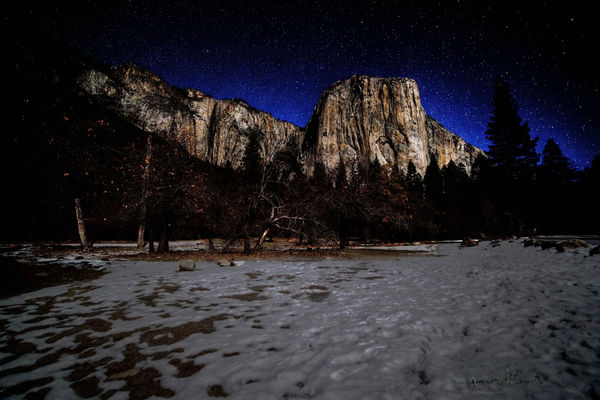Wide Angle Lenses and Star Trails
Mar 30, 2015 13:16:21 #
Recently, I had an opportunity to travel to Northern Sweden to photograph the Aurora Borealis. There were ten of us in the group, all with different equipment. After a night of shooting we would get together the next day and compare images. I was shooting with a 20mm lens/2.8 which was the widest of anybody. There were occasions when we would shoot the same image but my images showed less star trails than those with 24 or 28mm lens. This was hard to explain because we were all using the same exposure time. One person said that the wider the lens the less notable the star trail. Can anyone provide an explanation on why this might be true? We were all puzzled. Regards, Jack
Mar 30, 2015 13:46:16 #
This article explains it pretty well -
http://petapixel.com/2014/01/29/picking-great-lens-milky-way-photography/
For the star guru's to answer, post this question in the Astronomical Photography Forum
http://petapixel.com/2014/01/29/picking-great-lens-milky-way-photography/
For the star guru's to answer, post this question in the Astronomical Photography Forum
Mar 30, 2015 15:58:44 #
Shellback wrote:
This article explains it pretty well -
http://petapixel.com/2014/01/29/picking-great-lens-milky-way-photography/
For the star guru's to answer, post this question in the Astronomical Photography Forum
http://petapixel.com/2014/01/29/picking-great-lens-milky-way-photography/
For the star guru's to answer, post this question in the Astronomical Photography Forum
Dave, Thanks for this reference. Absolutely great and answered my question directly. Jack
Mar 31, 2015 00:46:25 #
Mar 31, 2015 06:41:11 #
Shotkit wrote:
great article! I'd never heard of the 500 rule before. Thanks for sharing.
Yeah, that is strange.
Mar 31, 2015 06:41:32 #
Shellback wrote:
This article explains it pretty well -
http://petapixel.com/2014/01/29/picking-great-lens-milky-way-photography/
For the star guru's to answer, post this question in the Astronomical Photography Forum
http://petapixel.com/2014/01/29/picking-great-lens-milky-way-photography/
For the star guru's to answer, post this question in the Astronomical Photography Forum
Thanks for the link.
Mar 31, 2015 06:56:21 #
Shotkit wrote:
great article! I'd never heard of the 500 rule before. Thanks for sharing.
The 500 rule "minimizes" the blur caused by the movement on our Earth. Some use 600, and the blur is minimal except on fair sized enlargements. If you can go with 400, the stars seem sharp even on your maximum enlargements. The wider the lens, the more flexible you can be. I shot this at f/2.8 for 20 seconds using a 15mm lens.
Mar 31, 2015 12:25:04 #
I have wanted to get star trails, but have not made the time to get out and do it. This 500 rule looks like it should prove to be helpful. Thank you.
Apr 1, 2015 12:49:47 #
Beautimus.
:thumbup:
Preachdude wrote:
The 500 rule "minimizes" the blur caused by the movement on our Earth. Some use 600, and the blur is minimal except on fair sized enlargements. If you can go with 400, the stars seem sharp even on your maximum enlargements. The wider the lens, the more flexible you can be. I shot this at f/2.8 for 20 seconds using a 15mm lens.
:thumbup:
Apr 1, 2015 16:41:59 #
Apr 1, 2015 17:15:30 #
Not possible. The wider the lens the lesser amount of exposure for star trails. Unless you have a Rock solid tripod you will get motion blur on your stars. I use a wireless trigger and still block the stars with my hat right at the time I press the remote, just for the mirror slap. Any wind will kill your shots as well.
bonjac wrote:
Recently, I had an opportunity to travel to Northe... (show quote)
Apr 1, 2015 17:36:33 #
TheDman
Loc: USA
martinfisherphoto wrote:
Not possible. The wider the lens the lesser amount of exposure for star trails.
Focal length doesn't affect exposure, and this isn't a question of exposure. Subject movement, whether it's stars, people, horses, etc is magnified with greater focal length. The wider the lens, the less the apparent motion of everything, stars included. So a 20 second exposure of the sky will show less star trails at 20mm than a 20 second exposure at 24mm, and that will be less than 28mm, etc.
Apr 1, 2015 17:42:23 #
The Wider the Lens the shorter the Focal length. You said the same then......
TheDman wrote:
Focal length doesn't affect exposure, and this isn't a question of exposure. Subject movement, whether it's stars, people, horses, etc is magnified with greater focal length. The wider the lens, the less the apparent motion of everything, stars included. So a 20 second exposure of the sky will show less star trails at 20mm than a 20 second exposure at 24mm, and that will be less than 28mm, etc.
Apr 1, 2015 17:42:49 #
TheDman
Loc: USA
martinfisherphoto wrote:
The Wider the Lens the shorter the Focal length. You said the same then......
The same as what?
Apr 1, 2015 18:23:30 #
The wider the lens the lesser amount of exposure for star trails. This doesn't read right. Should read: The wider the lens the less amount of star trails for same amounts of exposure.. The wider the lens, the longer you can expose before movement.
If you want to reply, then register here. Registration is free and your account is created instantly, so you can post right away.








